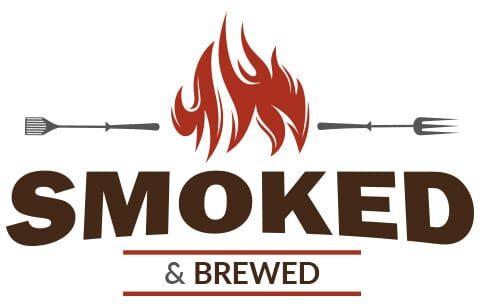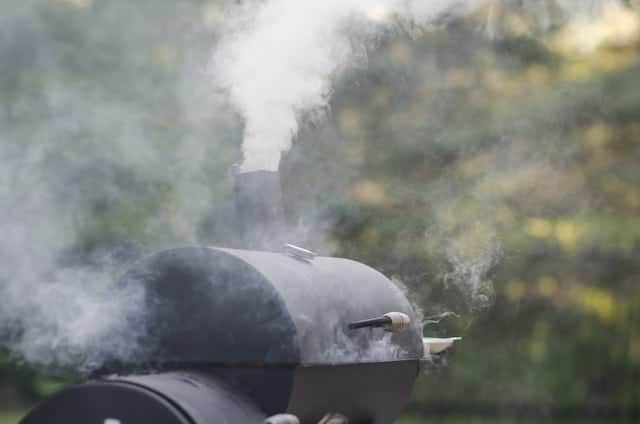When it comes to smoking, the quality of your fuel source is paramount for achieving your ideal barbeque flavor. The fuel source you use will affect every aspect of your smoke, from cook time to flavor, to the equipment you use. But not all fuel sources are created equal. And when it comes to choosing the one which works best for your smoke, it’s helpful to familiarize yourself with the most common fuel sources available, and what they bring to the table.
The eight best fuel sources for smokers are:
- Wood logs
- Wood chips
- Wood pellets
- Charcoal briquettes
- Hardwood charcoal lumps
- Propane
- Natural gas
- Electricity
In this post, I’ll review these fuels and weigh some of the pros and cons of each. By the end, I hope to help both aspiring and seasoned smokers make the right choices for their ideal smoke. So, if you’ve ever wanted to know what the differences are between these many different fuel choices, keep reading to find out!
1. Wood Logs
If you’re a barbeque purist, it doesn’t get any more traditional than logs. Wood logs are, without a doubt, the oldest fuel on this list– and, for many pitmasters, they’re the only choice. Logs are not only a great choice for a consistent heat source, but they’re also a go-to fuel for those smokers looking to impart a deep, smokey flavor into their meat.
Another benefit of wood logs is their abundance. If you’re willing to split the logs yourself, you can get much more fuel for far cheaper than the other fuels on this list.
The exact flavor you’ll get from your logs will largely depend on which type of wood you choose. The following are just a few of the wood types and their characteristics:
- Pecan: Smoky and sweet, this wood is known for its pungent aroma and pronounced flavor. Typically you would use pecan for shorter smokes to avoid imparting an overpowering flavor into your meat.
- Oak: A classic wood and a strong all-around choice for any kind of smoke. Oak burns consistently for a long time and has a mild flavor.
- Mesquite: While some smoking purists prefer the powerful aroma and pronounced flavor of mesquite, others find that the flavor of mesquite smoke can be a little overpowering. Compared to oak, this wood burns much hotter and faster.
- Hickory: If you like the slow, consistent burn you get from oak, but want something with a little more flavor, hickory is a great choice.
- Fruit woods: Fruit woods impart more distinctly mild and sweet flavors. These woods typically have longer burn times.
2. Wood Chips
If you like the flavor of wood logs but would like to have a little more control over the temperature of your smoke, wood chips may be the best option. With wood chips, the same flavor profiles apply as those covered in wood logs. Here are some of the differences to consider when deciding between chips and logs:
- Price: Because wood chips are processed, you’re going to pay more per pound than you would for whole logs.
- Better control: Wood chips are consistent in size and can be measured out by the ounce. This means you’ll be able to better calculate your smoke, by finding the exact amount of chips it takes to achieve your desired smoke.
- Flavor: While some smokers find no discernable difference between the flavor of chips and logs, others describe meats smoked with chips as having a burnt or bitter flavor. This is possible because the smaller chips char quicker than the larger ones.
3. Wood Pellets
The modern answer to efficient smoking, wood pellets are increasingly popular among serious smokers. Pellets are made from compressed sawdust and come in as many wood types as you’re likely to find among wood chips.
The benefits of smoking with pellets are numerous. The following are just a few:
- Better control: Each pellet is the same size and weight, meaning the smoker can calibrate their ideal smoking time following a specific amount of pellets, assured that each time they smoke using those pellets in the future, they can use the same amount.
- Consistency: Pellets are engineered to burn as consistently and evenly as possible, taking the guesswork out of smoking,
- No additional treatment required: While logs may need to be dried and wood chips require soaking, pellets need no special treatment from the pitmaster before heading to the smoker.
- Efficient: Compared to traditional wood, a relatively small amount of pellets are required per smoke. If you ask me, this justifies the higher-than-average cost of pellets.
4. Charcoal Briquettes
Another engineered smoking fuel, charcoal briquettes are also a great choice if you’re looking for consistency and efficiency. Charcoal is made by burning wood until it begins to carbonize. This creates a highly efficient and versatile fuel source that is great for smoking at any temperature.
Unlike with pellets, you don’t need a specialized smoker to use charcoal. Charcoal is also cheaper than pellets, on average.
One drawback of briquettes is that you won’t have as many flavor options as you will with other fuels.
5. Hardwood Charcoal Lumps
Newer, and a little more refined than charcoal briquettes, charcoal lumps provide the efficiency of briquettes with the flavor profiles of traditional wood. Charcoal lumps resemble organic wood in shape and texture. They also provide large amounts of consistent smoke, making them an obvious choice for both new and experienced smokers.
Smoking with charcoal lumps can take some getting used to, though. Their inconsistent size makes this fuel source somewhat unpredictable, and it can be a little temperamental when trying to maintain a certain temperature.
6. Propane
Propane burns cleanly and efficiently. This gas is a very common fuel source for both grills and smokers. Propane is easy to control, heats up quickly, and is affordable. And, because propane comes in canisters of all sizes, it’s perfect for on-the-go cooks.
However, don’t expect propane to provide much in the way of flavor. When burned, this gas becomes odorless. You’ll need to rely on seasoning and sauces to impart any flavor into your meat.
7. Natural Gas
There isn’t much of a distinction to be made between natural gas and propane. Natural gas burns clean and produces no odor. It’s easy to use and, unlike more traditional fuels, it both lights and heats up in seconds.
If you love the ease of cooking with gasses but prefer the flavor of natural woods, you can easily combine the two. Many smokers love the combination of gas and wood chips, as it eliminates the burden that comes with relying on wood as your primary heat source, while still allowing them to get that natural wood flavor that is impossible to replicate.
8. Electricity
Without a doubt the easiest fuel to work with on this list, electricity takes all the worry and guesswork out of barbeque. While you can’t call it “smoking,” electricity is certainly an efficient way to cook your meat. Because they require no additional hookups or fuel sources, electric smokers are typically smaller and more compact. This makes an electric smoker a great option for pitmasters looking for portability.
Again, don’t expect any additional flavor from an electric smoker. Think of them as closer to an oven than an actual smoker. As with an oven, setting the temperature of an electric smoker couldn’t be easier. Just turn the dial to your desired cooking temp and the smoker will do the rest.
Keep reading: How to Season a Smoker
Scot has loved smoking food in his free time for the last few years. Each major holiday or off-weekend, Scot spends days testing and prepping new recipes for perfection.

